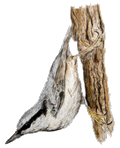
- Sherry Wine:
- Production
- Classification
- Cities & Bodegas
- Tastings
- Analogues
- Authors & Contacts
- Ðóññêèé ñàéò
Sherry analogues
Sherry analogues from the Jerez Region
Olga Nikandrova and Denis Shumakov.
In the Jerez Region itself, especially in the towns outside the Ageing and Maturation Zone, they produce quite a noticeable amount of fortified wines, which formally cannot be regarded sherries, but, based on a number of criteria, are very close to sherry. As a rule, such wines are not spread or win renown outside their native region.
Chipiona and Chiclana de la Frontera produce Moscatels not only from raisined grapes (which is then included in the sherry line) but also from non-raisined ones. They have golden color, slightly viscous, simple and sweet — they wonderfully carry out the role of local wine in the broadest sense of the word.
In these towns, bodegas working with Moscatel usually also make and sell wine with the standard sherry type names (Fino, Oloroso, etc) produced using all sherry procedures (even in compliance with some of Regulatory Council’s rules) from Palomino grape. But, since this wine is not aged within the Ageing and Maturing Zone, it cannot bear the name “Sherry”. In their taste and aroma, such wines, as a rule, are very close to their sherry-prototypes.
In Chiclana de la Frontera, besides usual pale Moscatel, they also produce Moscatel Naranja — that is Moscatel flavored with orange zest. Orange flavor is good for hiding high alcohol content, which is often sticks out in simple pale Moscatels and makes Moscatel Naranja comparatively more easy-drinking. Despite the fact that orange Moscatel is not unique for Chiclana (similar drinks are aso produced in Malaga, for example), it carries out the role of a local specialty quite well.
In the vicinity of the town of Rota, Tintilla de Rota (“the red one from Rota”), an indigenous grape variety, is used for making sweet fortified wine with the same name. The grapes are raisined and the wine itself undergoes long ageing in barrels, so “the red one from Rota” is not that red in color after all. It is often bottled into various non-standard small bottles and can be a good souvenir. The souvenir properties, however, are not the only advantage — it is a tasty and rather light dessert wine with pleasant figgy notes and tones of fresh fruit.
Finally, there are quite a number of ordinary dry wines produced in the Jerez Region. Some of them have associations with sherry. The brightest example of such wine is Castillo de San Diego. It is white wine made from Palomino grape by sherry producer Antonio Barbadillo in Sanlucar de Barrameda. This wine flows like water in the Jerez Region — the house spends half of its Palomino yield for its production. Castillo de San Diego wine is interesting not only for its unconditional consumer value, but also for the fact that it can be used in the academical perspective — as a bit far-fetched yet accessible and adequate example of what biologically aged dry sherry would taste before fortification and maturation.
Sherry analogies from the Jerez Region we have tasted so far (in Russian only):
— Bodegas J. Ferris M. Tintilla de Rota
— Bodegas San Sebastián Fino La Barrosa
— Bodegas San Sebastián Mariana Cream
— Bodegas San Sebastián Moscatel Blanco
— Bodegas San Sebastián Oloroso Seco
— Moscatel Gloria Naranja
— Tintilla de Rota J. Martínez
Warning!
This site can contain information about drinks excessive consumption of which may cause harm to health and is unadvisable for people who didn’t come of age.
Share Sherry
- Sherry.wine, FEDEJEREZ
- Copa Jerez, Sherry Week
- Sherry Notes, Jerez de Cine
- Los Generosos, Criadera
- Jerez-Xeres-Sherry
- Los Vinos de Jerez
Articles
- There are more articles in Russian than in English in this website. Sorry :(
Reviews
- To our great regret, we didn’t have time to translate tasting and traveling notes into English. But, if you want, you can see them in Russian.

